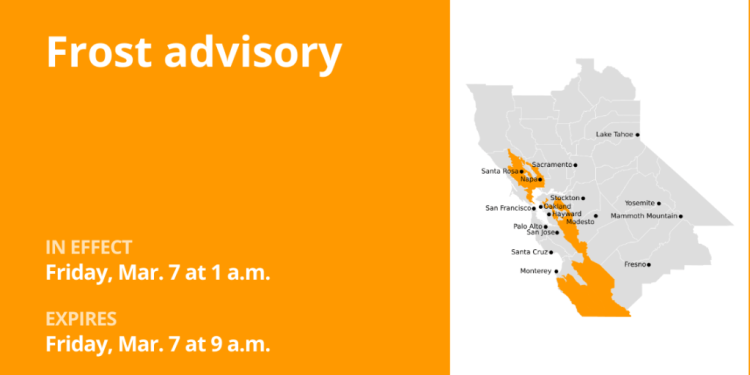The Bay Inland Regions region is under an updated freezing opinion that was published by the National Weather Service Thursday at 9:27 p.m., the Council is valid on Friday March 7 between 1 a.m. and 9 a.m.
The NWS San Francisco CA declares that it is ready for “temperatures as low as 32 degrees will cause freezing. Temperatures in higher elevations can fall at 28 years. »»
“The frost could harm sensitive external vegetation. Sensitive exterior plants can be killed if they are in the open. Cold conditions will be dangerous for sensitive populations such as individuals without housing. Cold conditions can cause hypothermia with prolonged exposure, ”according to the NWS. “Take measures now to protect tender plants from the cold.”
The complete list of affected locations includes:
- Interior valleys of the North Bay
- Hills of Santa Clara Orientales
- East Bay Hills
- Southern Salinas Valley / Arroyo Seco and Lake San Antonio
- Mountains of Santa Lucia and National Forest of Los Padres
- Mountains of the County of San Benito and the County of Monterey inside, including the Pinnacles National Park
Where to find winter weather shelters in your county:
Winter weather shelters in the County of Santa Clara: San Jose operates the night location program.
Winter meteorological shelters in the county of Alameda: list of winter shelters operated in the county of Alameda, health care of the county of Alameda for the homeless.
Winter weather shelters in the County of San Mateo: residents of the County of San Mateo who need a shelter should visit their local basic service agency to seek access to the weather program or other shelter programs.
Winter meteorological shelters in the Costa County County: for more information on how to connect with all emergency shelters at Costa, call 211 or click on the list of shelters provided by Contra Costa Health.
Winter meteorological shelters in Solano County: Solano County offers a list of centers where anyone can go warm during temperatures in extreme weather conditions.
Frost Advisory – that’s what it means
Gel notices are issued from May to October (but can be extended if necessary) when temperatures, winds and heaven cover are favorable to the development of frost. This is more likely to happen when the temperature is 36 degrees or less. In some cases, the frost is serious enough to end the growth season and is then called a “killing gel”.
According to the NWS, if a freeze notice is issued for your region, cover sensitive plants before sunset so that it can help keep heat near the plants, or move the plants inside for the night, if possible.
Originally published:
California Daily Newspapers


